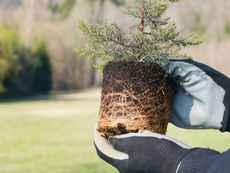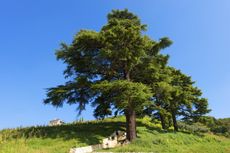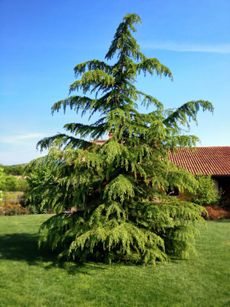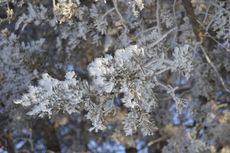Cedar Tree Care: Tips For How To Grow Cedar Trees

Attractive and normally trouble-free, cedar trees can be great additions to the landscape. To learn more about cedar tree care or how to grow cedar trees, you may find the following information helpful.
Facts About Cedar Trees
There are many types of cedar trees. All cedars are large, coniferous, evergreen trees. Because of their size, these trees are not often found in gardens and are usually seen lining streets or in parks. However, they make an excellent windbreak and are suitable on large pieces of property to add a living hedge or winter interest. They grow fast and can be found in a wide range of climate zones.
How to Grow Cedar Trees
Cedar trees are not hard to grow and will give elegance to any space where they have room to spread. The trees start easily from seed but require a 48-hour soaking period and another month in the refrigerator, along with some potting soil in a zip lock bag. The soil must be kept moist during this time. After a month, seeds can be placed in a paper cups with compost and potting soil mixture. Cups should be placed in a sunny window, and the potting soil should be kept moist. Plant the seedlings outside when they are 6 inches (15 cm.) tall. Select a sunny location carefully and do not plant trees any closer than five feet (1.5 m.) apart. Dig a hole that is three times the size of the cup and use high quality compost and native soil mixture to fill the hole. Place a 2-foot (0.5 m.) stake next to the tree and gently attach the seedling to the stake with garden twine.
How to Care for a Cedar Tree
Keep a 2-inch (5 cm.) layer of mulch around the tree, but not touching the trunk, to prevent moisture loss and protect the tree. It may be necessary to use a wire cage to prevent injury from mechanical devices as well. Protect young trees with a covering of landscape fabric if you live in a very cold climate. Water small trees regularly and allow them to dry out completely between each watering. Fertilizer is generally not necessary unless the soil is very unhealthy. Once the tree is mature, cedar tree care involves little more than regular mulching and removal of dead or diseased branches.
Cedar Tree Problems
While there are not too many cedar tree problems to deal with, several pesky insects are attracted to cedar trees including the cypress tip moth, root weevil, mites, and juniper scale. Infested trees generally exhibit symptoms including brown or yellow foliage, reduction of plant sap, white cocoons, or black, sooty mold. Horticultural oil or insecticide may be needed if infestation is extreme. Cedar trees are also yummy to dogs and rodents who enjoy munching on the bark. This can cause extensive damage if left unattended. Proper diagnosis and treatment is essential to prevent tree loss.
Gardening tips, videos, info and more delivered right to your inbox!
Sign up for the Gardening Know How newsletter today and receive a free download of our most popular eBook "How to Grow Delicious Tomatoes."
-
 Urban Beekeeping Guide: Top Tips For Raising Bees In The City
Urban Beekeeping Guide: Top Tips For Raising Bees In The CityUrban beekeeping can be a rewarding and appreciated pastime, but first be sure it’s legal in your city and learn the ropes of beekeeping.
By Mary Ellen Ellis
-
 2024 Plant Of The Year: Why Experts Say Philodendron Is The “It” Plant Of The Year
2024 Plant Of The Year: Why Experts Say Philodendron Is The “It” Plant Of The YearWe aren’t surprised that philodendron was designated the plant of the year. Versatile, easy-care and lovely, it’s the houseplant of the year 2024!
By Bonnie L. Grant
-
 Simple Tips For Transplanting Cedar Trees With Ease
Simple Tips For Transplanting Cedar Trees With EaseYou can transplant a cedar tree. These few tips will help you move your large cedar to a new location. Click for more.
By Teo Spengler
-
 Deodar Seed Planting Guide – How To Grow A Deodar Cedar From Seed
Deodar Seed Planting Guide – How To Grow A Deodar Cedar From SeedDeodar cedar is a beautiful conifer with soft blue foliage. Purchasing a tree can be expensive, but you can grow one from seed. Click here.
By Teo Spengler
-
 Cedar Of Lebanon Tree – How To Grow Lebanon Cedar Trees
Cedar Of Lebanon Tree – How To Grow Lebanon Cedar TreesThe cedar of Lebanon tree is an evergreen with beautiful wood that has been used for thousands of years. If you are interested in growing cedar of Lebanon trees, this article has tips about cedar of Lebanon care.
By Teo Spengler
-
 Blue Atlas Cedars: Caring For A Blue Atlas Cedar In The Garden
Blue Atlas Cedars: Caring For A Blue Atlas Cedar In The GardenBlue Atlas is among the most popular cedar cultivars in this country, with its beautiful powdery blue needles. For more information about Blue Atlas cedar trees and care, the following article can help. Click here to learn more.
By Teo Spengler
-
 When To Trim Cedar Trees: Guide To Pruning Cedar Trees In The Garden
When To Trim Cedar Trees: Guide To Pruning Cedar Trees In The GardenSome experts recommend against ever pruning cedar trees. However, if cutting back cedar trees is in the cards, proceed very carefully. This article contains information about how and when to trim cedar trees safely.
By Teo Spengler
-
 Winter Damage To Cedars: Repairing Winter Damage On Cedar Trees
Winter Damage To Cedars: Repairing Winter Damage On Cedar TreesAre you seeing dead needles appear on the outer edges of your cedars? This could be symptomatic of winter damage to cedars. This article contains information about cedar trees and winter damage. Click here to learn more.
By Teo Spengler
-
 Deodar Cedar Info: Tips On Growing Deodar Cedar In The Landscape
Deodar Cedar Info: Tips On Growing Deodar Cedar In The LandscapeIf you are thinking of growing deodar cedar trees, you will find these evergreens perfect for specimens or soft hedges. Find more details about deodar cedar care in the article that follows and see if this tree is well suited to your region.
By Teo Spengler